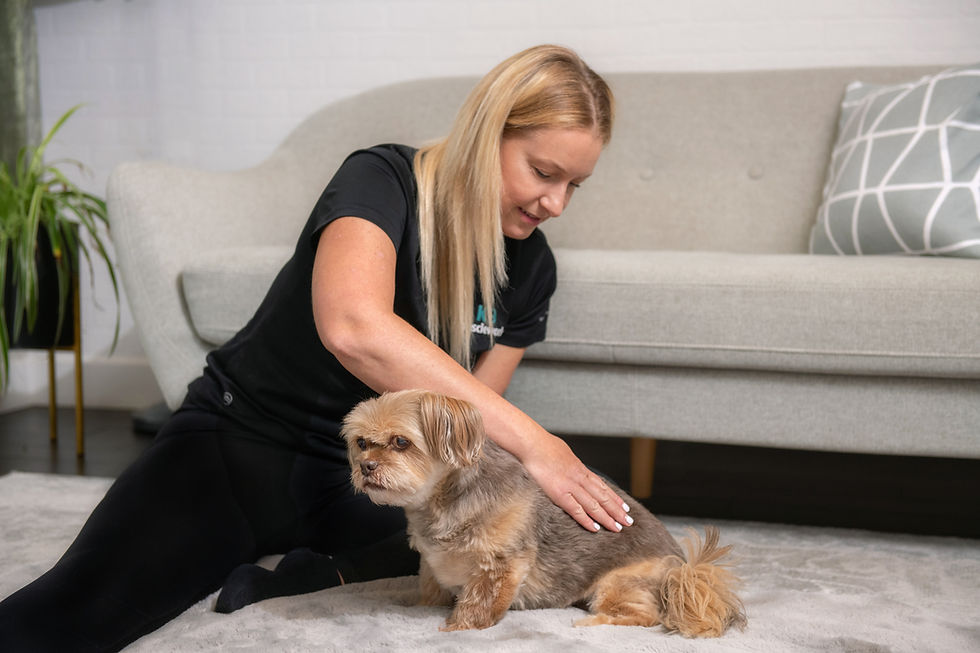Building Strength And Vitality: A Guide to Canine Muscle Maintenance
- K9MuscleWorks

- Jan 10, 2024
- 2 min read
Updated: Apr 14
Learn To Build Strength And Vitality For Your Canines Muscle Maintenance
Ensure your dog's well-being with proper nutrition, exercise, and care, emphasizing often-overlooked muscle health for agility, activity, and injury prevention.

Just like us, our canine companions benefit greatly from a healthy lifestyle that includes proper nutrition, exercise, and care. One crucial aspect often overlooked in dog care is maintaining their muscle health. Strong muscles are essential for their overall well-being, helping them stay active, agile, and less prone to injuries. Here’s a comprehensive guide on how to ensure you continue your canines muscle maintenance.
Balanced Nutrition
Adequate nutrition forms the foundation of good muscle health. Ensure your dog’s diet includes the following:
High-Quality Protein: Protein is crucial for muscle development and repair. Opt for dog foods with high-quality animal-based proteins like chicken, beef, or fish to support muscle growth and maintenance.
Essential Fatty Acids: Incorporate omega-3 and omega-6 fatty acids into their diet to reduce inflammation and support muscle function. Fish oil or flaxseed supplements can be beneficial.
Balanced Diet: Maintain a balanced diet with the right proportions of protein, fats, carbohydrates, vitamins, and minerals to support overall health, including muscle maintenance.
Exercise and Activity
Regular exercise is key to keeping your dog’s muscles toned and strong. Here’s how to ensure they get the right workout:

Daily Walks: Take your dog for daily walks to keep their muscles engaged and prevent stiffness. Adjust the intensity and duration based on your dog’s breed, age, and health condition.
Playtime and Games: Engage your furry friend in games that encourage movement, such as fetch, tug-of-war, or agility exercises. These activities not only strengthen muscles but also stimulate their minds.
Swimming: If possible, introduce your dog to swimming. It’s a low-impact exercise that engages multiple muscle groups and is especially beneficial for older dogs or those with joint issues.
Proper Rest and Recovery
Just like humans, dogs need adequate rest and recovery time to build and repair muscles. Ensure they have a comfortable resting space and enough downtime between exercise sessions.
Regular Veterinary Check-ups: Regular visits to the vet are crucial for monitoring your dog’s overall health, including their muscles. Your vet can identify any issues early on and provide guidance on maintaining muscle health.
Supplements and Therapies: Sometimes, supplements or therapies can aid in supporting muscle health:
Joint Supplements: For older dogs or those prone to joint issues, supplements like glucosamine and chondroitin can support joint and muscle health.
Physical Therapy: In certain cases, physical therapy such as massages or stretching exercises prescribed by a professional can help maintain and improve muscle strength.
Observing Signs of Muscle Health Issues
Stay vigilant for signs indicating potential muscle problems:
Limping or Difficulty Moving: This could indicate muscle strain or injury.
Reduced Activity: Sudden lethargy might signal muscle discomfort.
Muscle Atrophy: A visible decrease in muscle mass might indicate underlying health issues.
Maintaining canine muscle health involves a holistic approach encompassing nutrition, exercise, rest, and attentive care. By providing a balanced diet, regular exercise, proper rest, and seeking veterinary guidance when needed, you can ensure your beloved furry friend enjoys strong and healthy muscles, supporting their overall well-being and enhancing their quality of life. After all, a healthy pup is a happy pup!




Comments